
Feature Article
Practical Tips for Food Storage with Refrigerators and Freezers
Refrigerators and freezers are indispensable equipment for food storage. Proper food storage is essential to ensuring food safety as well as quality. This article will discuss the pros and cons of refrigeration and freezing, explain what kinds of food should be stored in the fridge and their storage periods, and the proper practices to keep food safe in the fridge.
Refrigeration versus Freezing – Are They the Same?
While both refrigeration and freezing can preserve food by keeping it at low temperatures and out of the temperature danger zoneNote 1, the conditions under which food is preserved are not identical. Refrigerated foods are kept at 4°C or below, under which the growth of many types of bacteria is inhibited. Most foods can maintain their textures upon storage under refrigeration. However, some types of bacteria, like Listeria monocytogenes, can still thrive at refrigerated temperatures. It is worth noting that Listeria monocytogenes, if present, can proliferate in the refrigerator over time and lead to foodborne illnesses.
In contrast, bacteria are forced into a dormant stage when foods are stored at –18°C or below. When compared with refrigeration, food spoilage is minimised because micro-biological development is inhibited. Besides, freezing food like fish at –20°C or below for seven days or at –35°C or below for about 20 hours can kill parasites in food manufacturing processes. However, some food may have quality issues upon freezing, which include freezer burnNote 2 in frozen meats, fat bloom (whitish or greyish coating) on chocolates and unstable oil-in-water emulsions (discrete aqueous and oil layers) in mayonnaise, making them unsuitable for food preparation. Prior to freezing or refrigerating food, it is advisable to prepare ahead and check which items can be kept fresh and nutritious.
Types and Storage Periods of Food in the Fridge
Some customers would prefer to buy a variety of products, including RTE food like siu-mei and raw food like fresh produce, at one go. Cross-contamination of RTE food with raw food may result from mixing the two types of food, causing cross-contamination of pathogens onto the RTE food.
In addition, the formats of food labels and nutrition labels of prepackaged food may be different from locally sold products. Some products may show manufacture dates rather than “use by” or “best before” dates required under the local labelling regulation. Besides, the nutrients shown on the nutrition labels may be different from the local requirements. Such deviations may result in misinterpretations.
Refrigeration and freezing are widely adopted in storing perishable foods including meats, seafood and processed foods like sausages. Nevertheless, not all food items are suitable to be kept in the fridge. Fruit and vegetables like bananas may be susceptible to chilling injury (damage or deterioration which occurs when food is exposed to temperatures below its optimal storage temperature). Chilling injury is a phenomenon that can reduce the quality of food and shorten its shelf life. Besides, shell eggs should not be put into freezers. Freezing shell eggs may alter their protein structure and cause the shells to crack. Eggs should be stored in the refrigerator rather than frozen.
Some may think that refrigerated and frozen foods have significantly longer shelf lives, but it should be noted that storage periods vary with the types of food. Refrigerated foods can still be spoiled after prolonged storage, while foods like fresh poultry can be kept for days for safe consumption. Of note, once the packaging of prepackaged food is opened, the date mark will become irrelevant. Follow the manufacturer’s instructions on the storage period and conditions after opening.

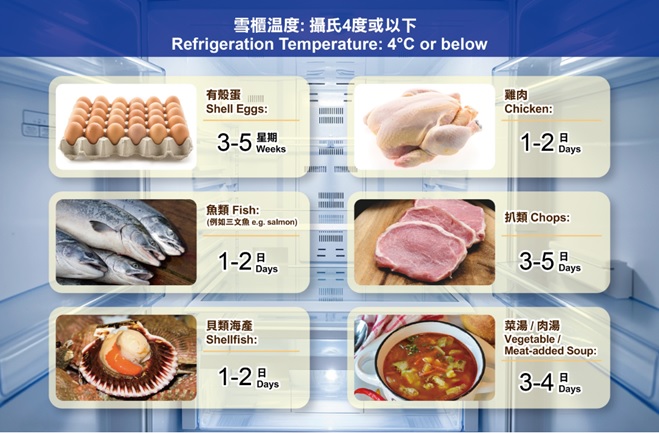
Figure 1: Storage periods of some refrigerated foods
(Source: Food and Drug Administration https://www.fda.gov/media/74435/download)
Separate Raw and Cooked Foods Properly and Keep Fridges Clean
Separating raw foods from ready-to-eat (RTE) and cooked foods is essential to preventing cross-contamination. Foods should be stored in covered or sealed containers before they are put into the fridge or freezer. Raw foods should be stored below cooked or RTE foods to prevent their juices from dripping onto the cooked or RTE foods, leading to cross-contamination. For large scale food storage, it is preferable to have different cold storage equipment for separating raw foods from RTE and cooked foods. Besides, fridges should be cleaned regularly.
Key Points to Note
- Refrigeration and freezing preserve foods by keeping them at low temperatures but under different conditions.
- While refrigeration and freezing can be used to store a wide range of foods and extend their shelf lives, these methods may not be suitable for preserving some food items.
- When refrigerating or freezing foods, raw foods should be separated from RTE and cooked foods.
- Clean the fridge and freezer compartments regularly.
Advice to the Trade
- Check the temperature log graphs of cold storage devices to make sure they function properly.
- Allow sufficient capacity for bulk storage of food stock.
- Maintain and service refrigerators regularly.
Note 1 To learn more about the temperature danger zone, please visit the following webpage or scan the relevant QR code.
https://www.cfs.gov.hk/english/trade_zone/safe_kitchen/Temperature_Danger_Zone.html

Note 2 For more information about “freezer burn”, please visit the following webpage or scan the relevant QR code.
https://www.cfs.gov.hk/english/multimedia/multimedia_pub/multimedia_pub_fsf_190_02.html

Mascot ON in Lesson
1. Plant-Based Meat - What are they and How do they Compare with Meat?
In the quest for sustainable eating habits, plant-based meat (PBM) has emerged as a popular alternative to conventional animal meat. Known also as meat substitutes or analogs, PBM products are manufactured to replicate the taste, texture and appearance of meat using plant-derived ingredients.
What is PBM?
Historically, Asian cuisines have utilised soy products to create vegetarian dishes akin to meat flavours. Examples include vegetarian chicken made from bean curd sheets and vegetarian lo mei produced from wheat gluten. Modern PBMs often comprise proteins from soy, wheat, peas and mushrooms, which provide the necessary texture and structure resembling meat. To enhance the sensory experience, ingredients like coconut oil are added for juiciness, while binders like methylcellulose ensure cohesion. Various seasonings are also added to enrich the flavour profile, mimicking the sensory experience of consuming conventional meat.

Figure 2: Production of PBM
Nutritional Composition and Comparison with Conventional Meat
While PBMs are noted for their environmental sustainability over meat, it is crucial to examine their nutritional profile compared with that of conventional meat. PBMs’ low cholesterol levels and often higher dietary fibre content are two of their main benefits. However, unlike meat, which is a complete protein source containing all essential amino acids, PBMs require careful combination with other proteins or the consumer has to take supplements to achieve a similar nutritional intake.
A study by researchers at the Chinese University of Hong Kong in 2023 revealed that over 270 prepackaged PBM products from 27 brands were available locally, with a significant percentage containing medium to high levels of fat, salt and sugar based on the information on the nutrition labels. These findings suggest that while PBMs can mimic the texture and taste of meat, they can also inherit some of the unhealthy attributes of processed foods. The World Health Organization (WHO) - Regional Office for Europe (WHO-Europe) has also highlighted that plant-based meals, especially those prepared outside the home, can contain a lot of salt. This indicates a gap in knowledge regarding the full nutritional composition of PBMs and how they contribute to a balanced diet as a whole.
The Importance of a Balanced Diet in Plant-Based Eating
A plant-based diet does not always equate to better health unless it is well-planned and balanced. PBMs may be deficient in some nutrients, such as vitamins B₁₂ and D, calcium, iron and certain essential amino acids, which highlights the need for careful dietary planning. WHO-Europe recommends opting for minimally processed plant foods to maximise health benefits. Consumers choosing PBMs should therefore be vigilant about the products’ nutritional content, which can vary widely between brands and types. It is always a good idea to read nutrition labels on prepackaged food and consider supplementing the diet with fortified foods or diverse plant sources to ensure the intake of all essential nutrients. Populations who have special nutrition needs and opt for vegetarian diets Note 1, including children, adolescents Note 2, pregnant women, lactating mothers, elderly persons and people with chronic diseases, should consult medical practitioners and dietitians in order to meet their special nutritional needs. Moreover, allergens that are usually not present in meat may be present in PBMs. People with food allergy should also look out for ingredients that they are allergic to, for example, soya, cereals grains (gluten) and nuts.
In conclusion, while PBMs offer a viable alternative for those seeking to reduce their meat consumption for ethical or environmental reasons, they should not be viewed as a direct nutritional substitute for animal meats. As an alternative, they ought to be incorporated into a diet consisting of a range of unprocessed plant foods and supplements may be needed to avoid any nutrient deficit. By making informed decisions and planning a diet that fulfills all nutritional requirements, people can enjoy the health benefits of a plant-based diet without compromising on nutritional quality.
Note 1: To learn more about “Guidelines for a Balanced Vegetarian Diet”, please visit the following webpage or scan the relevant QR code.
https://www.chp.gov.hk/en/static/90050.html

Note 2: For more information on “Vegetarian Diet and Nutrition”, please visit the following webpage or scan the relevant QR code.
https://www.studenthealth.gov.hk/english/health/health_dn/health_dn_vdn.html

2. Sweeteners: Myths and Facts
Sweeteners have been used for decades to help reduce sugar intake. Even though you may not add sweeteners in your diet, sweeteners are often used as ingredients in various food products, especially soft drinks and candies. Despite sweeteners’ long history of safe usage, there have been concerns about their potential health risks. In this article, we are dispelling some of the fallacies about sweeteners.
What are Sweeteners?
Sweeteners are food additives used instead of sugars to sweeten foods/beverages. Non-nutritive sweeteners, e.g. aspartame and saccharin, are substantially sweeter (30 to 20 000 times sweeter) than table sugar, thus only smaller amounts can achieve the same level of sweetness as sugars in food. Since only tiny amounts of non-nutritive sweeteners are required, their caloric contribution is negligible.
Another type of sweeteners is sugar alcohols (also known as polyols or polyhydric alcohols), e.g. sorbitol and xylitol, which are carbohydrates naturally found in small amounts in fruits and vegetables and can also be produced commercially. Unlike non-nutritive sweeteners, sugar alcohols are generally not as sweet as table sugar, with their sweetness ranging from 25% of 100% of that of table sugar. Since they are incompletely absorbed after ingestion, they contribute less calories as compared with sugars.
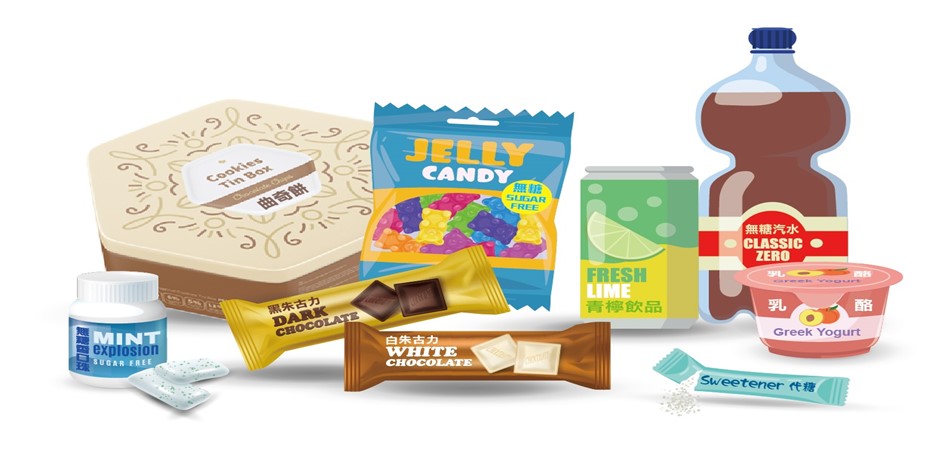
Figure 3: Common food products with sweeteners on the market
Truth about Sweeteners
Are all sweeteners artificial?
While some sweeteners are artificially made, e.g. aspartame and saccharin, some are derived from plants, e.g. steviol glycosides and sorbitol.
Are sweeteners safe?
Like other food additives, sweeteners have undergone rigorous safety evaluation before being permitted for food use. International and national food safety authorities, such as the Joint Food and Agriculture Organization of the United Nations/WHO Expert Committee on Food Additives (JECFA), evaluate the safety of sweeteners based on scientific reviews of all available toxicological and related data.
Concerns about sweeteners and cancer initially arose when early animal studies linked certain sweeteners (i.e. cyclamate and saccharin) with bladder cancer in laboratory animals. However, subsequent studies of the permitted sweeteners showed no evidence that sweeteners would cause cancer in humans. The International Agency for Research on Cancer (IARC) classified cyclamate and saccharin as “not classifiable as to their carcinogenicity to humans (Group 3)”.
Recently, IARC in 2023 classified aspartame as “possibly carcinogenic to humans (Group 2B)” based on limited evidence for carcinogenicity in humans. Nonetheless, JECFA, based on the evidence from animal and human studies, considered that aspartame had not been found to have adverse effects after ingestion, and that the evidence of an association between aspartame consumption and cancer in humans was not convincing. JECFA concluded that dietary exposure to aspartame within the previously established Acceptable Daily Intake of 0-40 mg/kg body weight did not pose a health concern.
Can sweeteners be used for weight control?
While sweeteners are safe for consumption, WHO released in 2023 a guideline which recommended against the use of non-sugar sweeteners (NSS) to control body weight. The recommendation was based on the findings of a systematic review of the available evidence which suggested that the use of NSS did not bring any long-term benefit in reducing body fat in adults/children. However, WHO pointed out that the evidence might have been confounded by the baseline characteristics of study participants and the complicated patterns of NSS use. WHO also remarked that the guideline did not apply to sugar alcohols or individuals with existing diabetes.
WHO advised that the key to weight control is to achieve an energy balance between calories consumed and burnt. People need to consider other ways to reduce free sugars intake, such as consuming food with naturally occurring sugars, like fruit, or unsweetened food and beverages. To improve health, people should reduce the sweetness of the diet altogether, starting early in life.
How are Sweeteners Regulated?
In Hong Kong, sweeteners are regulated under the Sweeteners in Food Regulations (Cap. 132U). At present, a total of ten permitted sweeteners are listed under Cap. 132U. To align with the latest international developments on the regulation of sweeteners in food, the Centre for Food Safety (CFS) has commenced the work to review the regulatory control of sweeteners. Sweeteners should be used under the condition of Good Manufacturing Practice with the quantity added to food limited to the lowest possible level necessary to accomplish the desired effect. Moreover, all prepackaged foods added with sweeteners are required to be properly labelled with their functional classes and specific names or identification numbers.
Advice to the Trade
- Reduce the sweetness of food products by using less sugar or fewer sweeteners.
- Ensure products comply with local requirements, including those on food additives and labelling.
Spot Check
1. Siu Mei Spy
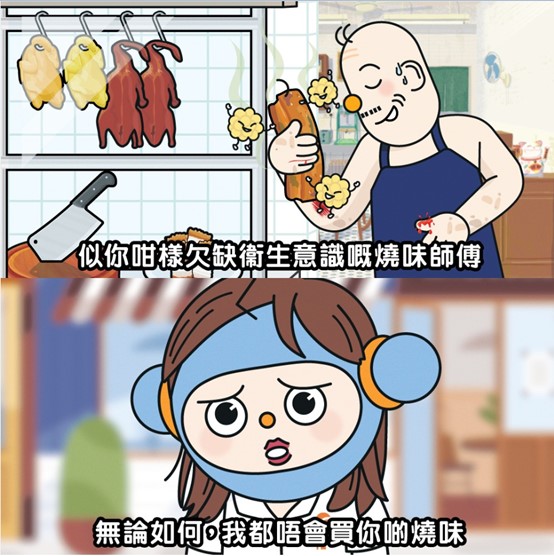
When it comes to quick, delicious and satisfying food for your one-hour lunch break, siu mei definitely earn a spot on the list. However, even thoroughly cooked, siu mei can still be contaminated with bacteria if it is displayed, cut or stored improperly.
There have been cases of food poisoning caused by the consumption of siu mei contaminated with Salmonella and Staphylococcus aureus.
https://www.cfs.gov.hk/english/multimedia/multimedia_pub/multimedia_pub_fsf_206_01.html

S. aureus are commonly found on the hair, skin, nasal cavity, throat and wounds of humans. When a food handler whose hands are contaminated with this bacterium handles (e.g. by cutting) siu mei, the siu mei will be contaminated. Moreover, S. aureus will grow exponentially and form heat-stable toxins if siu mei is stored at room temperature for extended period. Even if you reheat the siu mei afterwards, it won't help.
Therefore, next time when you buy siu mei, bear in mind the following:
- Patronise well-maintained licensed premises;
- Pay attention to the food handlers’ personal hygiene, e.g. wearing a face mask and clean overalls, and wearing their gloves properly;
- Check whether siu mei is displayed in an insect and dust proof showcase;
- When putting siu mei in your shopping cart or bags, keep it separate from raw food (especially raw meat and seafood);
- Consume the siu mei you bought as soon as possible.
What else should you watch out for? Check it out here:
https://www.cfs.gov.hk/english/programme/programme_rafs/programme_rafs_fm_01_27.html

2. Listeria Monocytogenes in Meat and Poultry Products
Recent news reported that about 10 million pounds of ready-to-eat (RTE) meat and poultry products were recalled in the United States due to possible Listeria monocytogenes contamination. Samples were tested positive for Listeria monocytogenes in routine product testing by the regulatory authority. The products recalled include prepackaged sandwiches, salads and pastas.
Listeria monocytogenes is a pathogen widely dispersed in the environment and food. RTE foods with longer shelf lives under refrigeration, such as RTE meat or poultry, are at higher risk, as Listeria monocytogenes may proliferate in these contaminated foods at refrigeration temperatures if given sufficient time. The bacteria can be killed by cooking. Listeria monocytogenes infection can cause listeriosis, with symptoms including fever, vomiting and diarrhoea. In pregnant women, the infection can result in miscarriages and stillbirths. Serious or fatal infections can occur in the elderly and individuals with weakened immunity.
The public should check if food packages are intact. Chilled food should be cooked or reheated thoroughly before consumption. The trade should maintain good hygiene and food handling practices during food manufacturing processes.
Safe Kitchen/Trade Talks/Food Safety Guidelines
Safe Kitchen
Introduction to Safe Kitchen Scheme
To facilitate the adoption of the 5 Keys to Food Safety and Good Hygiene Practices (GHPs) by trade members, and ensure food safety in their daily operation, the CFS has integrated the existing channels of risk communication and launched a new platform, namely “Safe Kitchen”, to communicate with the trade. The platform provides food safety information of greater practical importance to meet the operational needs of catering outlets.
The “Safe Kitchen” platform disseminates up-to-date food safety information (including food safety guidelines and relevant legislative amendments) to the trade through a host of channels including WhatsApp, emails and dedicated websites. In response to food poisoning outbreaks in restaurants, the platform also issues food alerts to remind the trade of the points to note in preventing future occurrences so that the risk of food poisoning can be minimised.
New dedicated websites and risk information exchange platforms will be rolled out under the “Safe Kitchen” Scheme. In addition, training materials tailor-made for the trade and workshops for kitchen staff will be provided to enhance food safety and hygiene awareness among them. Members of the trade are welcome to scan the QR code to download the registration form for the “Safe Kitchen” Scheme in order to receive the latest food safety information in a timely manner.

Trade Talks
Seasonal Food Safety Seminar
The CFS is organising the “Seasonal Food Safety Seminar” from April to December 2025. This programme aims to enhance the food trade’s understanding of the relevant information and explain how to take the effective food safety control measures to ensure the safety of food products. All members of the food trade are welcome to attend the seminar, which will be conducted in Cantonese and is free of charge. Furthermore, each participant will receive a certificate of attendance (to be dispatched by post after the seminar).
Seminar Topics:
“Seminar on Import, Manufacture, and Sale of Rice Dumplings”;
“Seminar on Food Safety – Manufacturing of Frozen Confections”;
“Seminar on Import, Manufacture, and Sale of Mooncakes”;
“Seminar on Manufacture and Sale of Poon Choi”;
“Seminar on Buffet Style Catering”; and
“Seminar on Food Safety for Chinese New Year Foods”.
Members of the trade who are interested in attending the “Seasonal Food Safety Seminar” are welcome to scan the relevant QR code for online registration.

https://www.cfs.gov.hk/english/committee/forms/seasonal_seminar.html
Food Safety Guidelines
Pre-cut Fruits and Fresh Fruit and Vegetable Juices - Food Safety Guidelines for Food Businesses
Processing fresh produce into fresh-cut products or juices, which breaks the natural exterior barrier of the produce, increases the risk of bacterial growth and contamination. Pre-cut fruits and fresh juices, often served cold, are considered high-risk foods as the ingredients do not undergo any heat treatment before consumption. Disease-causing bacteria like Listeria monocytogenes, Salmonella spp. and Shiga toxin-producing Escherichia coli may be present in some common ingredients such as apples and oranges. Additionally, damaged or mouldy fruit may be contaminated with mycotoxins, particularly patulin, which may pose health hazards. Processing fresh produce without good personal and environmental hygiene will also increase the risk of contamination by microorganisms with antimicrobial resistance (i.e., “superbugs”). To ensure the safety of pre-cut fruits and fresh juices, food handlers should look out for potential food safety issues in the preparation process and take appropriate measures.
For more details on food safety measures required for preparing and selling pre-cut fruits and fresh juices at food premises, please click the following link or scan the relevant QR code to view or download the guidelines online for reference.
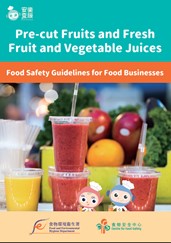
https://www.cfs.gov.hk/english/multimedia/multimedia_pub/files/Precut%20Fruits_A5_eng.pdf

Salads – Food Safety Guidelines for Food Businesses
Since salads are ready-to-eat food products with high risks, hygiene management during their production process is of utmost importance. Tailored to the trade’s needs, Salads – Food Safety Guidelines for Food Businesses published by the CFS provides comprehensive advice on the purchase, storage and preparation of salads.
It is highlighted in the guidelines that the risks of salads mainly stem from raw ingredients (e.g. vegetables and eggs) and multiple handling procedures, making salads susceptible to contamination with pathogens such as Listeria monocytogenes. In view of this, the trade must strictly control the source of ingredients (e.g. choosing and using pasteurized egg products and pre-washed vegetables), handle raw and cooked food separately, and ensure that the storage temperature is kept below 4°C. In addition, maintaining environmental and personal hygiene is equally important. Therefore, it is advisable to sanitise utensils regularly, wear disposable gloves and prevent sick staff from handling food.
While the guidelines are not mandatory, they consolidate the core principles of Good Hygiene Practices to help the trade establish a preventive management system. The implementation of these measures will not only protect consumers’ health, but also enhance the trade’s professional image. Trade members may click the following link or scan the relevant QR code to view or download the guidelines online for reference:
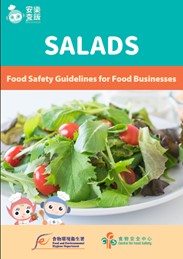
https://www.cfs.gov.hk/english/multimedia/multimedia_pub/files/salads.pdf

News on CFS
1. CFS’ announcement of study results on consumer acceptance of reformulated dim sum with reduced sodium
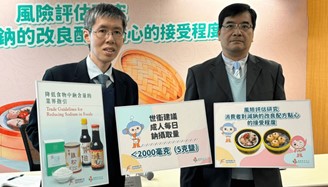
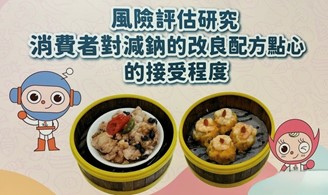
The CFS held a press briefing on 13 January for the publication of the report on the study results on consumer acceptance of reformulated dim sum with reduced sodium. The results indicate that consumers accept a 10 to 20 per cent reduction of the sodium content in dim sum, suggesting that reducing the sodium content in dim sum is feasible for the industry.
For more information, please visit:
https://www.cfs.gov.hk/english/press/20250113_11391.html

2. The 88th Meeting of the Trade Consultation Forum
The 88th meeting of the Trade Consultation Forum was held on 27 March 2025. The CFS and the trade exchanged their views on topics including “Risk assessment study on microbiological quality of packaged rice balls”, “Risk assessment study on consumer acceptance of reformulated dim sum for sodium reduction”, “Proposal on regulation of konjac-containing jelly confectionery”, and “Advance release arrangement for Hong Kong-manufactured food products entering the Mainland market”. For details of the event, please visit:
https://www.cfs.gov.hk/english/committee/Notes_and_Presentation_Materials_TCF88_20250312.html


3. Trade Talks and Workshops on GHP and Hazard Analysis and Critical Control Point (HACCP) 2025
The CFS’s trade talks and workshops on GHP and HACCP 2025 are scheduled to take place from March through October this year. The primary objective of this programme is to publicise proper food handling practices among food trade practitioners. Through the trade’s active participation and collaboration with the government, the programme also aims to encourage the trade to adopt GHP and the HACCP system, as well as to implement a Food Safety Plan in the food manufacturing process, so as to enhance food safety.
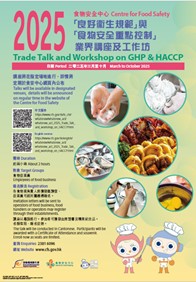

4. Promotion of the Habit of Eating Adequate Fruit by CFS and the Department of Health (DH)
The CFS has always supported the “Joyful Fruit Month” initiated by the DH. The campaign aims to promote the habit of eating adequate fruit every day and has received widespread support from schools and various sectors of the community over the years.
In April this year, the CFS even put up community posters with the theme of “Joyful Fruit Month” in public markets under the Food and Environmental Hygiene Department (FEHD) to continue to create a cheerful atmosphere and disseminate health messages.

Ask Our Mascots
Keeping raw meat away
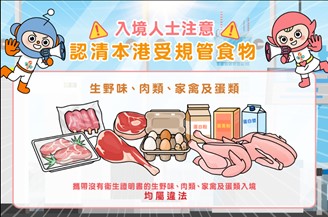
It is common for people to bring souvenirs back to Hong Kong after travelling, but unfortunately, some “new faces” are not so welcome at customs! Our mascots would like to remind you not to bring regulated food such as raw meat, game, poultry and eggs into Hong Kong illegally!
According to the Imported Game, Meat, Poultry and Eggs Regulations (Cap. 132AK), regulated food, whether for personal use or not, has to be accompanied by a health certificate issued by the issuing entity of the place of origin or written permission from the FEHD. Offenders are liable on conviction to a maximum fine of $50,000 and imprisonment for six months.
What’s more, foods that merely have the packaging designs and materials changed (such as those packed in foil or vacuum packaging) are still subject to the regulations.
When bringing food into Hong Kong, remember to comply with the requirements of the relevant local laws!
Enhancement Quiz
1. Which of the following food should not be stored in the fridge?
a) Fish
b) Chicken
c) Shell Eggs
d) Steak
2. Which plants are the sources of the protein usually found in plant-based meat?
a) Soy, peas and wheat
b) Beef, chicken and pork
c) Fish, eggs and dairy products
d) Vegetables, fruits, and grains
3. What is the main cause of ciguatera fish poisoning?
a) Consuming raw meat
b) Consuming coral reef fish containing ciguatoxin
c) Consuming expired dairy products
d) Drinking untreated water
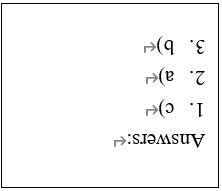
Diary of Mascot ON
1. Norovirus in Kimchi
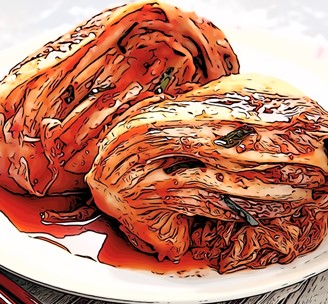
In July 2024, there was a food poisoning outbreak involving 1 000 victims in South Korea linked to the consumption of kimchi contaminated by norovirus. The manufacturing, distribution and sale of all products of the incriminated company were subsequently suspended.
Norovirus is the most common viral agent causing acute gastroenteritis worldwide in the form of outbreaks and sporadic cases in humans. It can be spread by the faecal-oral route via food and water contaminated with faeces. Besides, person-to-person contact, contact with contaminated objects and aerosol spread are other major routes of transmission. People suffering from norovirus food poisoning may show symptoms which include nausea, vomiting, diarrhoea and abdominal cramps.
To reduce the food safety risk of norovirus, members of the public are advised to observe good personal and environmental hygiene. Wash hands thoroughly with liquid soap and water after using the toilet, before handling food and before eating. The trade should remind food handlers who exhibit gastrointestinal symptoms to stop handling food. Food handlers infected by norovirus should be symptom-free for at least 48 hours before resuming work.
2. Clams in Preserved Fish Sauce and Vibrio parahaemolyticus
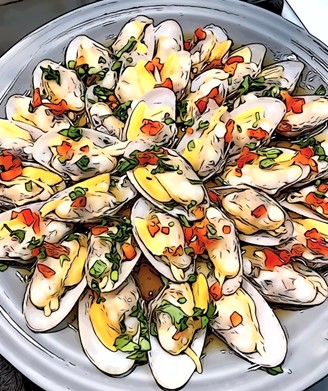
In 2024, clusters of food poisoning incidents involving the consumption of clams in preserved fish sauce in a restaurant were reported. The affected product was stopped from sale and discarded upon the CFS’s instruction. During the CFS’s investigation, a sample of clam in preserved fish sauce collected from the food premises concerned was found to contain an excessive amount of Vibrio parahaemolyticus (VP) Note 1
VP can cause food poisoning. It is naturally present in seawater and is often found in seafood. Food poisoning caused by VP is usually associated with the consumption of undercooked or raw seafood, in particular shellfish contaminated with bacteria. Cross-contamination can also occur when raw food comes into contact with cooked or ready-to-eat (RTE) food. Common symptoms of food poisoning caused by VP include diarrhoea, vomiting, mild fever and abdominal pain.
To prevent VP-related food poisoning, store food in a covered or sealed container in a refrigerator to avoid contact between raw food and cooked or RTE food. Separate equipment should be used for handling raw and cooked or RTE food. Food should be cooked thoroughly before consumption.
Note 1: For details of the implicated sample of clam in preserved fish sauce, please visit:
https://www.cfs.gov.hk/english/press/20240905_11128.html
